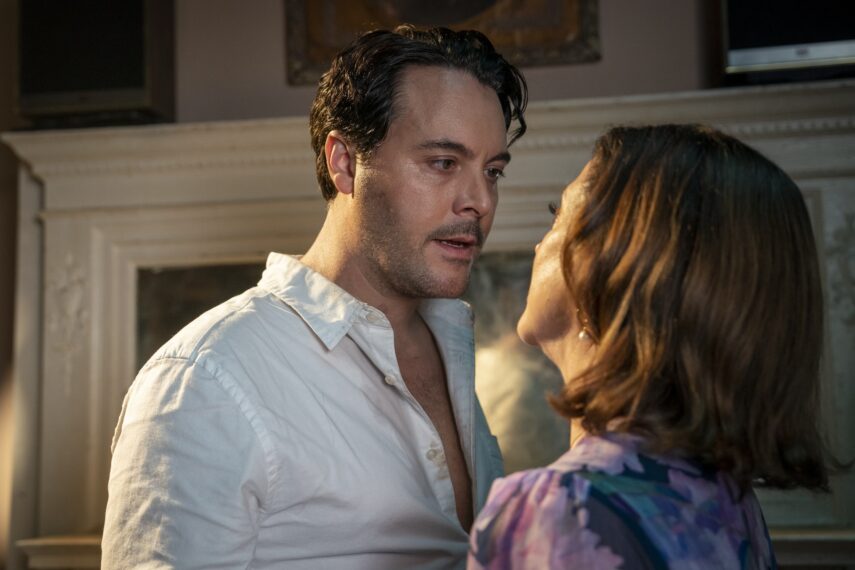[Warning: The following contains MAJOR spoilers for Mayfair Witches Season 2 Episode 2, “Ten of Swords.” This post also contains discussions of sexual assault.]
Here’s something creepy: The newly birthed, now-fully-grown Lasher (Jack Huston) can literally smell Mayfair witches from miles away. He’s hunting them down in Mayfair Witches‘ second season, but he can’t remember why. And he definitely doesn’t understand why things go so wrong when he finds them, but that hardly absolves him of guilt. The Mayfair women are dropping like flies by Lasher’s hand, and Thora Birch‘s Gifford Mayfair was his latest victim in Mayfair Witches Season 2 Episode 2, which aired Sunday, January 12 on AMC.
Gifford’s fate was sealed in Anne Rice‘s Lasher novel, the second of three books in The Lives of the Mayfair Witches trilogy. But there were some slight changes made for this brief deadly encounter in the episode’s opening scene. For starters, book Gifford had an underused power of foresight; she could sense something bad was going to happen just before it did. In the show, she has strong intuition but it’s not necessarily magical, and she channels her gut feelings through tarot reading. She always prioritized her family before herself, but Episode 2 shows her stepping back from the family to take care of herself for once like in the novel. Her husband calls, rudely urging her to come back from the New Orleans lake house (it’s a Florida beach house in the book) and help the family. She’s married to her Mayfair cousin, Ryan, in the novel, and that’s neither confirmed nor denied in the episode (that’s just the tip of the twisted gothic horror iceberg you’ll find in Rice’s writing). And then, Lasher mysteriously arrives at her house.
In an adaptation of a brutal scene from Lasher, Huston and Birch’s characters are immediately drawn to each other, but Gifford can’t sense the threat Lasher poses because of some magical force that’s blinding her to it (Lasher doesn’t understand it either yet). Their brief sexual encounter leads to her hemorrhaging as if she’s having a miscarriage and dying painfully. In the episode, there is no informed consent to this hookup. In the book, it’s more clear that Lasher coerced and raped Gifford. The threat of human Lasher for the Mayfair women is that they couldn’t resist his pull if they tried. This Gifford scene is the start of a season-long mystery about why Lasher is trying to mate with Mayfair women now that he’s in adult human form.
Decades after playing Dani in Hocus Pocus, Mayfair Witches shows Birch in a witchy tale once more. Here, she breaks down her guest star role with TV Insider, from adapting Gifford’s tragic book plot to being a lifelong Rice fan.
Every Mayfair woman has a unique talent. What is Gifford’s? And is there another reason why she’s distancing herself from the family right now other than seeing danger in her tarot cards?
Thora Birch: Wishing that she had some [laughs]. She’s a prominent, socially, member of the family and definitely one of the more wealthier ones. But I think if she had a quarter of Rowan’s [Alexandra Daddario] power, she’d just be over the moon. She’s definitely going through a weird phase. She’s becoming a little bit more reclusive. We get the sense that she’s not exactly getting along with her husband too well and has kind of just been hiding out in her beach house. And she’s getting deeper and deeper pulled into reading the tarot, which is her obsession. But she’s sensing this impending doom and she’s uncertain as to what it is, if it’s specific to her or just a threat to her family. But she definitely feels a negative force coming her way. And then she encounters Lasher, and it becomes unclear as to who’s seducing who. But that does happen. And then, yeah, she’s got a little bit of a wild ride from there. But she’s a fun character. She fits in with the Mayfair witches, but she’s a little bit of an oddball as well.
Is your Gifford self-taught in tarot or did she learn from a family member? Does she have any magic powers like Moira’s [Alyssa Jirrels] mind reading?
I think she started off by going to a number of tarot readers, and then as one will with a new obsession, did a deep dive into it. I know a lot of people who are into tarot that have that quality too, which is they’ll do a reading and they’ll get a sense of something, but if they don’t like it, they’re like, shuffle the cards. Do it again. It’s like keep doing it until you hear what you want to hear. She’s not getting anything that she wants to hear, so she gets the same message. And just as a Mayfair herself, she’s a little bit more susceptible [to supernatural powers], or at least she keeps convincing herself of that. So she wants to be able to play in that space. But as far as any actual supernatural powers, no, she doesn’t [have any]. She just has the Mayfair blood.
Which is what draws Lasher to her. So he can sense where all of them are?
He can literally sniff them out.
And it’s impossible for these women to resist him, and that’s the threat of him?
Right. He’s kryptonite.
Which explains why when he arrives to her house, she’s curious about him instead of afraid.
Right, no thought to the impending doom she was just talking about [laughs].

Skip Bolen / AMC
Can she tell who he is, like can she sense that he is a magical presence? Or does his power blind her completely?
I think he’s quite physically, like on a cellular level, irresistible to her. But there’s also something about her, which is just, again, I’m stocking it up to her bloodline, that he’s drawn into, so they’re mutually intoxicated by each other without really knowing why or understanding what it means, and maybe having a sense that nothing good could come of it. I think she just is taken away by his power.
Is her beach house in New Orleans, not Florida like in the book? I’m wondering how far Lasher’s ability to “sniff them out” goes.
Well, we shot it about a 40-minute drive outside [New Orleans]. When we first got to the house, it looked a little bit like if the west coast of Florida had their own version of Architectural Digest, this would’ve been it. But then the art department came in and tricked it out and made it feel a little bit more Louisiana-ish. So in the show, it’s supposed to be that. She’s close. She’s far off on her beach house, a little secluded from the city and everything, but I don’t think it’s meant to actually be Florida.
In the book, Gifford took care of other people before herself, and to my understanding, ignored her own intuition in some ways. But in this episode, we see that she’s self-preserving. What’s the backstory here? What already happened that led to her creating this distance with her family?
She’s reached this point where she had been involved in [the family], like a supportive wife and playing the socialite role, and now she’s trying to find her own voice, taking a step back and thinking about what does she need, why is there this feeling, what’s going on, people in my family are dying and I don’t know why, and who’s this Rowan chick? How dare she come along and take all our power? [Laughs] That was the emotional backstory that I had put upon her because I knew that in the world of the show, it’s a loose adaptation from the books. So for the purposes of the journey and the story, where Gifford’s at right now is not how she normally is. This is an odd moment in her life.
And there’s a little bit of an element of wish fulfillment in this because her dream came true. She finally did encounter the darker elements of her family’s power, so she got in the world at the end, all right.
Showrunner Esta Spalding told us that this beach scene was something from the book that they wanted to honor this season. What were some details from that that were important for you all to include?
For me, it was just more trying to understand her vulnerability, because that’s not something a woman of her station — and it’s not even a very Mayfair-like quality to feel fully vulnerable. Lasher offers her an opportunity to forget that she’s a Mayfair and just be swept up into this very quick, dark, brooding, mysterious fling that she just wants to have some fun with and abandon herself and not worry about all of the things that she’s been worrying about or the pressures that her family would have her under. She’s just taking that moment for herself.
Given the Hocus Pocus connection of it all, I love to see you in a witchy role. Did filming Hocus Pocus at such a young age inspire a lifelong love of witchy media for you afterward? What did that do for you?
I don’t know how uncommon it is, but I did pretend to be a Wiccan for a couple of years there when I was 14 to 15. I think just like a lot of young women, I was always drawn into the occult and was already an Anne Rice fan. Love vampires, loved the whole New Orleans of it all. I love that this show treats [New Orleans] like another character, which was Anne Rice’s calling card as well, so it’s a fun space to play in. But I always loved Halloween and things like that, and vampires more than zombies, even though I was on Walking Dead as well [laughs]. So this [witchy stories] has always been a little bit more fun. It’s visually playful. Good clothes, great jewelry, you can’t go wrong.
Mayfair Witches, Sundays, 9/8c, AMC, Streaming Sundays on AMC+


























